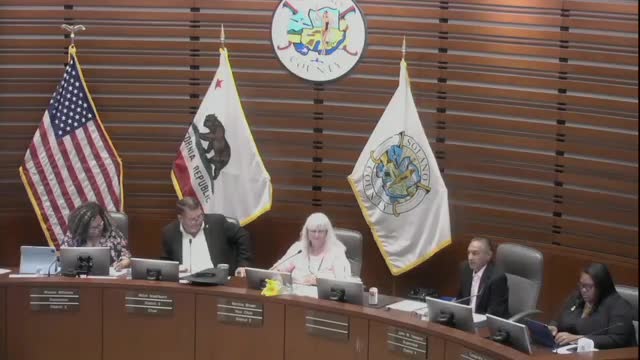Solano County Develops Comprehensive Ordinance for Front of Meter Energy Storage Systems
August 12, 2025 | Solano County, California
This article was created by AI summarizing key points discussed. AI makes mistakes, so for full details and context, please refer to the video of the full meeting. Please report any errors so we can fix them. Report an error »

In the heart of Solano County, a pivotal meeting unfolded as the Board of Supervisors grappled with the complexities of energy storage regulations. The atmosphere was charged with a sense of urgency as officials sought to strike a balance between fostering innovation and ensuring public safety.
At the forefront of the discussions was the proposed ordinance aimed at regulating large-scale energy storage systems, particularly those located "front of the meter," which serve the broader electrical grid. Board members expressed concerns about the potential risks associated with these systems, particularly the phenomenon known as thermal runaway—a dangerous condition that can lead to fires or explosions. One supervisor candidly shared their skepticism about the assurances provided by project developers, reflecting a broader apprehension about the safety of new technologies.
The meeting highlighted a critical issue: the perceived double standard in project approvals. Some developers might opt for state-level approvals, which could involve less stringent standards than those set by the county. This disparity raised questions about fairness in the regulatory process, prompting supervisors to emphasize the need for an ordinance that is neither overly restrictive nor too lenient.
To inform the ordinance's development, a technical working group has been established, comprising representatives from various sectors, including local agriculture, emergency services, and the energy industry. This collaborative approach aims to incorporate diverse perspectives and expertise, ensuring that the ordinance is comprehensive and addresses community concerns effectively.
As the board reviewed the proposed regulations, they underscored the importance of public safety and the need for thorough permitting processes. The ordinance would require pre-application meetings with relevant agencies and a technical review fee to fund expert analysis of complex materials. Each permit would also undergo a discretionary review process, allowing for public input and scrutiny.
The meeting concluded with a commitment to continue refining the ordinance, balancing the need for energy innovation with the imperative of safeguarding the community. As Solano County navigates this critical juncture, the decisions made today will shape the future of energy storage and its impact on residents for years to come.
At the forefront of the discussions was the proposed ordinance aimed at regulating large-scale energy storage systems, particularly those located "front of the meter," which serve the broader electrical grid. Board members expressed concerns about the potential risks associated with these systems, particularly the phenomenon known as thermal runaway—a dangerous condition that can lead to fires or explosions. One supervisor candidly shared their skepticism about the assurances provided by project developers, reflecting a broader apprehension about the safety of new technologies.
The meeting highlighted a critical issue: the perceived double standard in project approvals. Some developers might opt for state-level approvals, which could involve less stringent standards than those set by the county. This disparity raised questions about fairness in the regulatory process, prompting supervisors to emphasize the need for an ordinance that is neither overly restrictive nor too lenient.
To inform the ordinance's development, a technical working group has been established, comprising representatives from various sectors, including local agriculture, emergency services, and the energy industry. This collaborative approach aims to incorporate diverse perspectives and expertise, ensuring that the ordinance is comprehensive and addresses community concerns effectively.
As the board reviewed the proposed regulations, they underscored the importance of public safety and the need for thorough permitting processes. The ordinance would require pre-application meetings with relevant agencies and a technical review fee to fund expert analysis of complex materials. Each permit would also undergo a discretionary review process, allowing for public input and scrutiny.
The meeting concluded with a commitment to continue refining the ordinance, balancing the need for energy innovation with the imperative of safeguarding the community. As Solano County navigates this critical juncture, the decisions made today will shape the future of energy storage and its impact on residents for years to come.
View full meeting
This article is based on a recent meeting—watch the full video and explore the complete transcript for deeper insights into the discussion.
View full meeting
